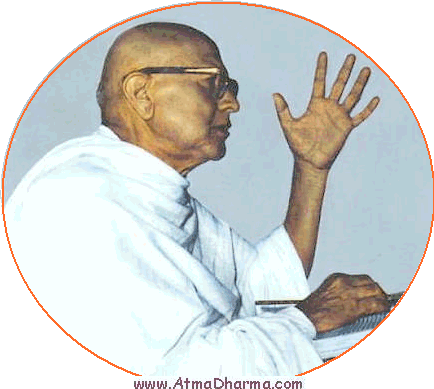
Kanji Swami a Revolutionary?
When the baby Kanji was born on 21st April 1890 (Vaishakh Sud 2, Vikram Samvat 1946), the vast majority of Jains were under the impression that Jainism was about not hurting other living beings and practising rituals such as fasting, worship, etc.. There was very little understanding of the concept of mithyatva and it's antidote – bhedgnaan.
Gurudev KanjiSwami explained the concept of mithyatva as the core reason for endless births and deaths. He attained self-realisation and preached the method of self-realisation by bhedgnaan using the existing scriptures to explain the logic and the process. This revolutionary view was in complete contrast to the conventional beliefs and practices of the time. Even in the current times, relatively few people understand the essence and significance of mithyatva and bhedgnaan.
Life before Monkhood
Gurudevshree Kanjiswami was born in Umrala, Gujarat, on 21st April 1890 (Vaishakh Sud 2, Vikram Samvat 1946) to mother Ujamba and father Motichandbhai. Kanji took basic education in Umrala but moved to Palej, near Vadodara, with his father as his mother passed away when he was only 11 years old. He joined his father's grocery business at the age of 17. Despite being very clever he was exteremely honest in business and never took unfair advantage of anyone. Even though the business was increasing rapidly, Kanji was not interested in material wealth. So while running the shop, the time between attending customers was spent reading scriptures. Kanji would also close up shop when Jain monks would come to town so that he could look after their needs and to listen to their discourses. He told his elder brother Khushalbhai that he was not keen on marriage and took Swetambar Sthankvasi renunciation at the age of 24.
Life as a Sthanakvasi Monk
From the beginning of his monkhood, KanjiMuni followed the path with the clear objective of self-realisation. To this end, he studied the scriptures diligently and questioningly while his conduct was also sincere and no defects were allowed. He read all the Sthanakvasi and Swetamber books studiously 17 times. He identified inconsistencies and departures from principles in these books and concluded that the true path to self-realisation was not in these “scriptures”.
The moment of Truth
KanjiMuni had an open mind and so when in the year 1912 AD (Vikram Samvat 1978) Kundkund Acharya's 'Samaysaar' was given to him by a Sthanakvasi follower, he studied it and realised that it described the truth that he was seeking. Samaysaar describes the soul and how to experience it. In Samaysar Gatha 5, Kundkund Acharya says “If I show you your soul, then you must verify that by self-experience”. Gurudev KanjiSwami did just that.
After in depth study of Samaysar and then Moksh Marg Prakashak by Pandit Todarmalji, Gurudev KanjiSwami felt uneasy with being in an order (Sthanakvasi) whose core beliefs were not true and so decided to leave Sthanakvasi monkhood and become a Digamber householder. As KanjiMuni was the jewel in the crown of the Sthanakvasi sect many inducements and threats were made to stop him leaving. However the seeker of the truth was not held back by bribes or threats. On the birthday of Lord Mahavir in 1935 AD (V.S. 1991) in the building called “Star of India”, Songadh in Saurashtra region of Gujarat, KanjiMuni renounced Sthanakvasi monkhood and became a Digamber householder.
Life as a Digamber Householder
In Songadh, Gurudev KanjiSwami continued his studies and lectured regularly for 45 years. The lectures were primarily focused on:-
- the nature of the soul
- how to see/experience the soul
While always covering the above two key points, Gurudev would touch on lots of other aspects such as the life stories of inspiring people (Prathamanuyog), the consequences of karma (Karnanuyog), 6 substances (Dravyanuyog), conduct of Munis (Charanuyog), etc..
Gurudev studied nearly 200 scriptures and lectured on many of them. However, the one shastra that Gurudev lectured on continually was Samaysaar. At the time of his passing away in 1980, he had been lecturing on Samaysaar for the 19th time. In private, Gurudev had read Samaysaar countless times.
Gurudev studiously avoided asking anyone to do any activity other than to understand themselves.
Inspiration
Gurudevshree Kanjiswami's life inspires us to understand the nature of mithyatva and bhedgnaan. He is our guide to salvation. During Gurudev's time, there were many accomplished and capable people who valued his preachings:
- One of them, Navnitbhai, instigated the recording of Gurudev's lectures. The result was more than 9000 audio lectures are now available. This is our treasure/inheritance along with shastras such as Samaysaar. These lectures are available online and are being actively studied by people across the whole world. Efforts are on currently to produce word for word transcripts of the audio lectures. All this effort is a tribute to Gurudev's inspiration.
- Other people such as Bahenshree Champaben, Bahen Shantaben, Nihalbhai Sogani, Pujya Lalchandbhai Modi experienced their soul. Their material is also available online.
Temporary separation
On 28th November 1980 (Vikram Samvat 2037 Kartak Vad 7) Gurudevshree left his earthly body creating a void in our world that cannot be filled even by other Gnaanis because Gurudev was a unique combination of so many worthy attributes. Even though Gurudev is not physically with us, his recorded lectures and transcripts (describing what the soul is and how to experience it) are with us so let us all make the most of this opportunity to understand ourselves before our time to depart this world is over. If we do so, we will meet up again with Gurudev on the path to salvation.
